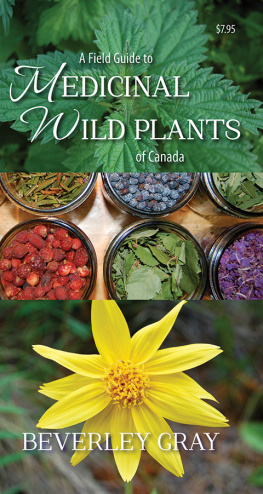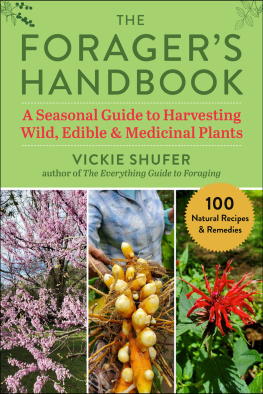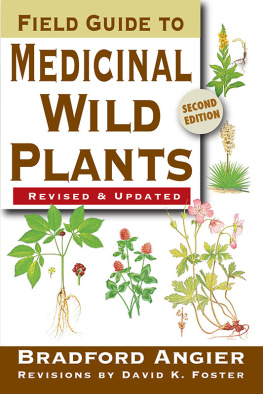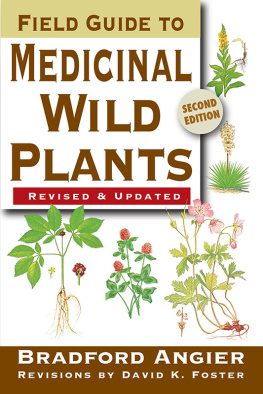
Devils club berries ripen in summer
PACIFIC NORTHWEST
MEDICINAL PLANTS
IDENTIFY, HARVEST, AND USE
 120 WILD HERBS
120 WILD HERBS
FOR HEALTH AND WELLNESS
SCOTT KLOOS

This book is dedicated to my beautiful
and amazing wife, Kathryn, without whom
none of this would have been possible,
to those who came before us and prepared a
fertile ground for our generation to flourish,
especially Michael Moore and Cascade Anderson
Geller, and to my dear sons, Joaquin and Finn,
and all the children, the ones here now and
the ones who are coming. May your
relationships with the plants and
connection to the earth ever deepen.
CONTENTS

Pacific dogwood flowers illuminate the forest and show us who we are.
PREFACE
My first field guides still sit on a bookshelf in my office at home. Each crease, dirt smudge, dried plant specimen, and dog-eared page in those books is a testament to days of adventure pregnant with the promise of meeting new plant friends and allies in the forests, mountains, valleys, and deserts of my cherished Pacific Northwest home. I used those books so much that the information they contained became a part of me, but one day I knew it was time for me to take off the training wheels and leave the field guides at home.
I very clearly remember that day. It was a day tinged with sadness because knowing the plants well enough to leave the books behind also meant saying goodbye to the thrill of discovery and the wonderment that propelled me on many epic quests. At the time I knew there would always be new things to discover, relationships to deepen, and aspects of nature to wonder upon, but it would never be like it was in those early days.
If you are just beginning your journey on this green path, I envy you. Out in the wild, many new friends and allies await. Amid the earths myriad flowering colors and the infinite shades of green knowledge within her whispering leaves, you will experience the excitement, joy, and awe that comes when you finally discover and meet a new plant thats been calling to you. Instead of just gazing longingly at the pictures in this book, you will have the opportunity to smell the sweet scent of the flowers, stroke the subtle fuzz on the underside of the leaves, and watch how the plants sway in the wind to greet you as you enter the forest.
Getting to know plants is like meeting a lifelong friend. You will need to give as much or more than you receive. It takes dedication to develop these relationships, but you will never be alone again. Wherever you go you will be surrounded by friends. Like the books that inspired me, I hope that this book helps you find, remember, and renew your connection to the wild. You will meet plants that grow along your favorite hiking trails and in your neighborhood park, plants that grow way out in the mountains and absolutely wont grow in anybodys garden, and others that will happily grow in your garden or that thrive in ground disturbed by the presence of humans. The thing that unites these plants is that they grow without our aid and sometimes despite our attempts to eradicate them. They embody the forces of nature and possess a spirit that renews and invigorates our own wildness. By connecting with and using these plants as medicine, we can retune our physical bodies in relationship to the land. By connecting with the wild places within ourselves and by harvesting and making medicine from these wild plants, we remember how to be in harmony with nature.
How did I get started on this path? After watching my grandparents die without dignity in the hospital, I was unable to go near a hospital for years without having a panic attack. These and other mainstream health care experiences affected me deeply. I knew that I never wanted to end up in the hospital. Even as a teenager, I knew that the hospital was not a suitable environment for healing. It was a place to die, not a place to get well.
In my early twenties, I started learning about herbs and wanted to make my own medicine because I was sure that civilization had no interest in my well-being and, in any case, it was headed for a collapse. I knew that if I wanted to survive the downfall, I would have to take matters into my own hands. As Ive cultivated this rebellious spirit of self-reliance over the years, my views on how to bring about societal change have shifted. Rather than hunker down and wait for the end of civilization, Ive spent the majority of my adult life making medicines to share with my community, empowering others to do the same, and teaching classes that allow people to experience the magic and power of plant medicine so that we ourselves can shape the world in which we want to live.
The wild plants have become my friends and teachers. Harvesting them to make medicine has brought health and happiness to my life on so many levels. While I understand that wild plants will never be the main supply of medicine for the modern world, they will always have their place.
Health care is a right all humans ought to share equally. As people continue to become disillusioned with a system increasingly dependent on developing new drugs to increase profits for shareholders, it becomes more important that we have access to medicines that grow in the backyards, fields, meadows, and wild areas near our homes. It is refreshing to return to the roots of healing and find natural remedies that support our own health and well-being as well as that of our families and friends.
Wild medicinal plants carry a different medicine than herbs cultivated in gardens. They not only create the conditions for physical health and inspire harmony within our bodies, but they remind us of the wild places within ourselves and connect us to nature. Can we truly be healthy without a connection to the foundations of all life here on Earth? I say no, and in my experience it is this disconnect that is at the root of so much of our current dis-ease as a society.
Retaining and developing a connection to the wild through making medicine from and ingesting wild medicinal plants can enliven and invigorate our lives in a very special way. It can lead us to the remembrance of a culture that respects the land and all creatures of the earth, one that is guided by the very same principles that the natural world uses to organize itself.

Dawn breaks over a high desert creek lined with sagebrush and cottonwood.
So now I take another step on my path as I write this book for you. I am honored to share the knowledge that Ive gathered in more than two decades of wildcrafting, medicine making, and working with plant medicine. Connecting with these plants has helped me connect with parts of myself that have been marginalized, pushed aside, and forgotten. By studying these plants and the places where they grow, I remember who I am. I see their dignity, power, and beauty reflected in me. I remember my indigenous self as the presence of the ancestors who lived intimately with these landsdigging roots, gathering leaves, and making medicine by the cycles of the moonreverberates through my being.
Next page






 120 WILD HERBS
120 WILD HERBS


